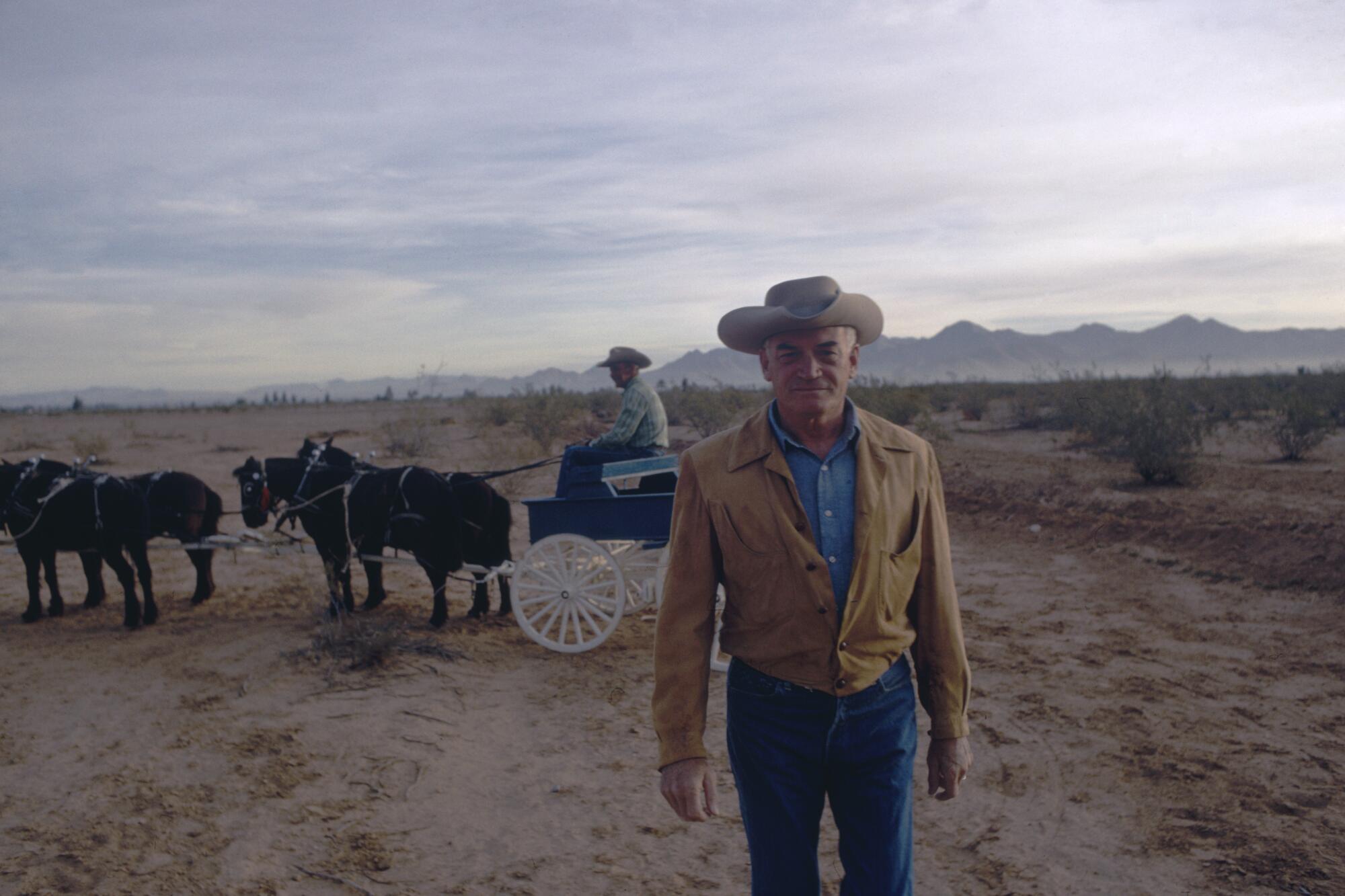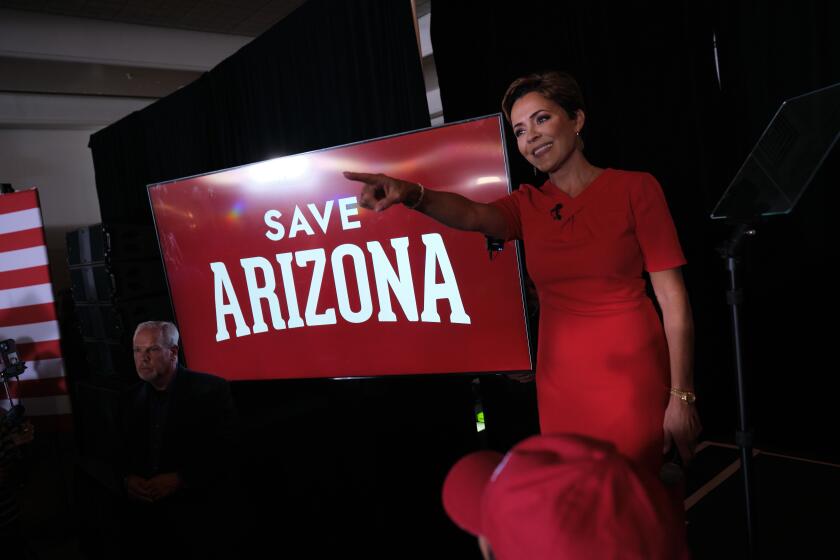
- Share via
When Arizona Sen. Barry Goldwater contemplated a run for president in the 1964 election, he introduced himself to a national audience by releasing a photo of himself dressed in a buckskin jacket, cowboy hat and jeans, holding an antique rifle on his knee. He looked every inch the frontiersman — except for the swimming pool in the background.
Those who knew Goldwater might have chuckled at another detail. Although his family had genuine 19th century Arizona roots, they had made their fortune in department stores, not ranching. One of Barry’s only contributions to the business before he left to chase a political career was designing a line of blouses and drapes featuring cattle brands.
Day trippers from California, traffic jams and lack of housing for workers are fueling local fights over tourism and marketing.
The use of retail cowboy duds to project a conservative image of toughness, independence and suspicion of government is an Arizona tradition at least as old as Goldwater’s failed presidential campaign.
But even as the real trade of cowboying has virtually disappeared in modern Arizona — direct cattle sales make up less than 0.0014% of the state’s GDP — the strategic use of Western attire to broadcast right-leaning ideology has only increased and seems to be getting even stronger.
Why is Arizona poised to give away groundwater to mining when it faces a devastating water crisis?
A legal loophole in the state’s water laws may allow huge amounts of limited groundwater for a destructive copper mining project on the sacred Oak Flat site.
“As big as Arizona has grown, it is in our political DNA,” Republican political consultant Stan Barnes said of cowboy iconography. “When you come to Arizona, you’re subject to the culture, and if you’re in political life, you see that culture distilled.”
Of the 90 members of the 2024 Arizona Legislature, five are wearing cowboy hats in their official state portraits. All of them are Republicans. But only one is an actual rancher with cattle. “It means someone who rides for the brand,” said that lawmaker, Rep. David Cook, known at the Capitol as a down-to-earth deal maker. He compares his governing philosophy to moving livestock. “You get them all together and move them together,” he said.
Through most of the last 150 years, Arizona has been a geography of personal reinvention, ambitious and fraudulent schemes and hype that exceeded nature’s limits.
The politician-cowpoke theme comes drenched in several ironies, not least of which is that when Arizona was run by a Democratic Party machine for most of the 20th century, there were far more ranchers serving in public office and their livery was both more common and less partisan.
Gov. Jack Williams declared the bolo tie “Arizona’s official neckwear” in 1971, and when Tom Prezelski, a Democrat from Tucson, wore his own ornamental leather cravat on the floor of the Legislature 15 years ago, nobody blinked. Now he gets a different question when he wears it: “Have you turned into a Republican?”
“You now adopt the fashion to make a political statement,” Prezelski complained. “It’s all code. It didn’t used to be that way. Now you get all these Republicans looking like norteño musicians.” Anyone who wants a front row to Deep Arizona should go to the state Capitol whenever the state’s 15 county sheriffs arrive to lobby for something. Nearly all of them wear cowboy hats, looking like a family reunion out of Wyatt Earp days.
Here lies another irony. As a profession, cowboying flourished only for a brief period, roughly from 1865 to 1895, when it was a low-paid agricultural job, often taken up by Mexican immigrants and African Americans — not the core of today’s Republican base, to say the least.
The equestrian tradition of Western cattle raising is derivative not of anything Anglos brought to conquered Indigenous land but of the northern Mexican vaquero tradition. The cowboy hat is a modified sombrero. Even the core lingo comes from the Spanish language: lariat, corral, chaps.
But historical details don’t seem to matter. The aesthetics are used to conjure up a politics of frontier individualism — they go hand in hand. “One does affect the other,” said Barnes. “They feed off each other.”
These signifiers work because voters embrace them too. It’s a common story for newcomers to Arizona to lean into the fantasy Western lifestyle by decorating their homes with oil paintings of shootouts and roundups. Even interior design carries political influences these days.
“A lot of people respond to it,” said Jim West, a longtime Phoenix country disc jockey. “It boils down to looking out for yourself, taking care of your people, and small government.”
But not every politician can pull off the look.
Mark Finchem, a former police officer from Michigan, ran a heavily MAGA conspiracy-oriented campaign for secretary of state in 2022. On the campaign trail, he sported an unconvincing combination of string tie and cowboy hat. That earned him the nickname Kalamazoo cosplay cowboy.
Some see a darker message in the aesthetic. J. Gray Sweeney, a professor emeritus of art history at Arizona State University, wrote in an article, “Racism, Nationalism, and Nostalgia in Cowboy Art,” that “the supporters of western art are willing to do everything in their power to protect the cherished fantasy of America’s ‘winning of the West,’ ” which is “premised on nationalistic and conservative values.”
That impulse has gotten only stronger in recent years, especially in the Trump era, Sweeney explained to me. “I can tell you without any reservations whatsoever that the people who collected this kind of nostalgia-ridden art are uniformly conservative politically, as the art is about preserving some values that are regressive and largely of a white supremacist type.”
Of course, the supposed golden age of the Arizona rangelands in the late 19th century was also a time when Anglo settlement depended on government largesse in the form of land giveaways to the railroads, loose mining concessions and military supply contracts. A later generation of ranchers would never have stayed in business if it weren’t for generous public grazing leases, plus federal dams for all that water.
So when Arizona politicians take to dressing up Western-style, they’re paying homage to an era not of rugged individualism but of a Washington-driven economy subsidized by taxpayers. Giddyup!
Tom Zoellner is the author of “Rim to River: Looking into the Heart of Arizona.”
More to Read
A cure for the common opinion
Get thought-provoking perspectives with our weekly newsletter.
You may occasionally receive promotional content from the Los Angeles Times.












